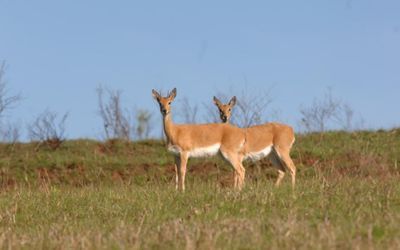
Scientific Name:
Shoulder Height:
Mass:
Gestation:
Diet:
This gracious little antelope has a long, slender neck and legs. Ears are oval. The coat is rufous-brown with white under parts. The tail of the oribi is black. Situated close to the inner corners of the eyes are two large pre-orbital glands. Only the rams have short, straight horns of 80 -180 mm, which are ringed at the base. Found in small monogamous groups of a ram with two ewes. These groups are territorial, and actively defend their territories of 25-100 ha in size. Territorial rams evict young rams from their family group, whereas young ewes remain longer until they can form their own pair bonds. Since it is important to maintain social bonds, a family regularly performs a dunging ceremony, although dung middens are not maintained.
Inhabits floodplains, grasslands, open plains and montane grasslands, and marginally in light bushland. Distribution is patchy and discontinuous. In South Africa Oribi occur in the northern parts of the Eastern Cape, KwaZulu-Natal, Mpumalanga, and small populations persist in the north eastern Free State and Swaziland. Rare in the eastern Caprivi of Namibia and northeastern parts of Botswana.





© Eastern Cape & Karoo Safaris – 2023 | Web Resources | Hunting Safaris in South Africa Website Design and Search Engine Optimisation (SEO) by ZAWebs cc | Web Hosting by ZAWebHosts cc
WhatsApp us